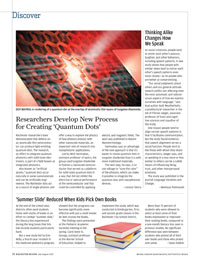Discover
 DOT MATRIX: A rendering of a quantum dot at the overlap of atomically thin layers of tungsten diselenide. (Photo: Michael Osadciw)
DOT MATRIX: A rendering of a quantum dot at the overlap of atomically thin layers of tungsten diselenide. (Photo: Michael Osadciw)Rochester researchers have demonstrated that defects on an atomically thin semiconductor can produce light-emitting quantum dots. The research, an effort to integrate quantum photonics with solid-state electronics, is part of a field known as integrated photonics.
Also known as “artificial atoms,” quantum dots occur naturally in some nanomaterials and can be artificially engineered. The Rochester dots act as a source of single photons and offer a way to explore the physics of how photons interact with other nanoscale materials, an important vein of research into nanophotonic applications.
Led by Nick Vamivakas, assistant professor of optics, the group used tungsten diselenide to fashion a nanoscale semiconductor that served as a platform for solid-state quantum dots in a way that did not inhibit the electrical or optical performance of the semiconductor and that could be controlled by applying electric and magnetic fields. The work was published in Nature Nanotechnology.
Vamivakas says an advantage of the new approach is that it’s easier to create quantum dots in tungsten diselenide than it is with more traditional materials.
The next step, he says, is to use voltage to “tune the color” of the photons, which can make it possible to integrate the quantum dots with nanophotonic devices.
—Leonor Sierra
Thinking Alike Changes How We Speak
As social creatures, people tend to mimic each other’s posture, laughter, and other behaviors, including speech patterns. A new study shows that people with similar views tend to mirror each other’s speech patterns even more closely—as do people who are better at compromising.
“Our social judgments about others and our general attitude toward conflict are affecting even the most automatic and subconscious aspects of how we express ourselves with language,” says lead author Kodi Weatherholtz, a postdoctoral researcher in the lab of Florian Jaeger, associate professor of brain and cognitive sciences and coauthor of the study.
One reason people tend to align certain speech patterns is that it facilitates communication. But the study found evidence that speech alignment serves a social function. People tend to like those with whom they share characteristics, Jaeger says, and so speaking in a way more or less similar to others can be a subtle means of influencing liking, trust, and other interpersonal emotions.
The study was published in the journal Language Variation and Change.
—Monique Patenaude
‘Summer Slide’ Reduced When Kids Pick Own Books
At the end of the school year, districts often send students home with stacks of books in an effort to combat “summer slide,” the literacy loss experienced during the long break that hits low-income students particularly hard.
But a new study led by Erin Kelly, a fourth-year resident in the medicine-pediatrics program, showed that the programs can become significantly more effective with just a small tweak: let kids choose the books.
The findings were presented at the Pediatric Academic Societies meeting in the spring. Carol Anne St. George, assistant professor at the Warner School of Education, helped to implement the study, which was conducted in kindergarten, first-, and second-grade classes in the Rochester City School District.
More than 75 percent of students who were allowed to select at least some of their books maintained or improved their reading levels, compared to a one-month literacy loss seen in previous studies. No significant difference was seen between students who picked all of their own books and those who picked only some.
—Sean Dobbin
Pollution Linked to Lower Birth Weight
Women in Beijing who were pregnant during the 2008 Olympics, when pollution levels were reduced by the Chinese government, gave birth to children with higher birth weights compared to those who were pregnant before or after the games.
That’s according to a study led by David Rich, associate professor in the Departments of Public Health Sciences and Environmental Medicine, which suggests that pollution may be interfering with fetal development.
In the months leading up to and during the Olympics and Paralympics, the government launched a series of aggressive measures to improve Beijing’s notoriously poor air quality, including restricting automobile and truck use, closing factories, halting construction projects, and seeding clouds to induce rainfall.
The controls—which were relaxed after the games—produced a significant decrease in air pollution for a six- to seven-week period during the games, including a 60 percent reduction in sulfur dioxide and a 48 percent reduction in carbon monoxide.
The researchers compared birth weights of infants born to women whose eighth month of pregnancy occurred during the games with those whose eighth month occurred at the same time of year in 2007 and 2009.
They found that babies born in 2008 were on average 23 grams larger than those born the year before and the year after. The research was published in the journal Environmental Health Perspectives. Late pregnancy is a particularly important time for fetal growth, when the most physical growth occurs and development of the cardiovascular, central nervous, and musculoskeletal systems accelerates.
—Mark Michaud
Study Sheds New Light on Brain’s Power Source
The brain requires enormous energy to do its job. While it represents only 2 percent of the average adult’s body mass, the brain consumes about 20 percent of the body’s energy supply. As a result, figuring out just how brain cells—specifically, neurons— generate energy has significant implications for understanding basic biology as well as neurological diseases that may be linked to too little or too much metabolism in the brain.
Now a new study, led by Maiken Nedergaard, the Frank P. Smith Professor of Neurosurgery and codirector of the Center for Translational Neuromedicine, shows that neurons in the brain are more independent than previously thought.
In research published in Nature Communications, the scientists found that neurons—and not astrocytes, as previously believed—take up more glucose in the brain, with consumption rising with brain activity and falling when the brain isn’t stimulated. With astrocytes, the uptake stayed relatively constant.
Understanding the “precise and complex biological mechanisms of the brain” is critical to dealing with neurological diseases, says Nedergaard. “If we are looking in the wrong place, we won’t be able to find the right answers.”
—Mark Michaud

